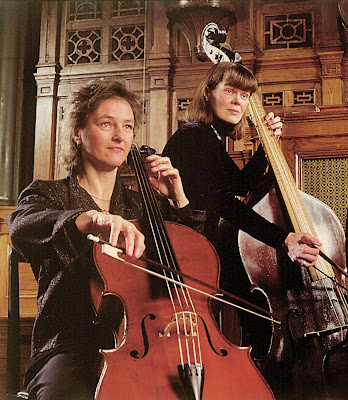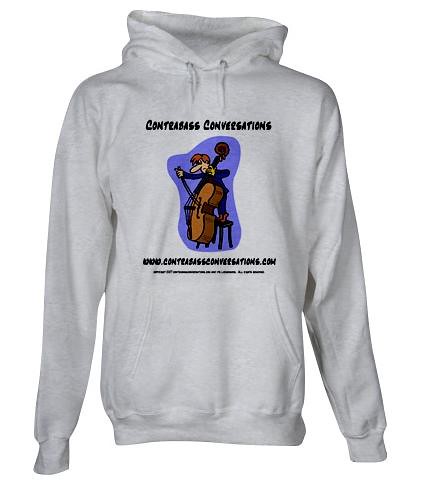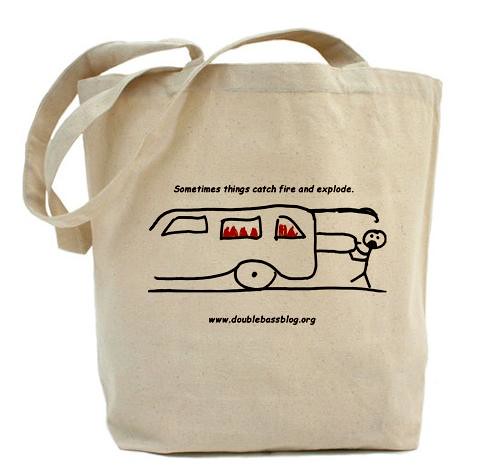The following is a guest post from Double Bass Blog contributor Phillip W. Serna. Check out Phillip’s recitals and interviews on his Contrabass Conversations page, and visit him online at http://www.phillipwserna.com/. Enjoy!
__________________
Contrabass Conversations and the Double Bass Blog are continues is series on early bass performers. It will highlight many different perspectives on early bass/ violone performance. Our next guest is Tafelmusik’s Alison Mackay. We hope that you will enjoy these interviews and glean a good deal of information from our esteemed guests.
About Alison Mackay:
Alison Mackay has played violone and double bass with Tafelmusik since 1979. She is active in the planning of educational projects for the orchestra and her children’s tale Baroque Adventure: The Quest for Arundo Donax, released on the Analekta label, was awarded the Juno Award for 2006 Children’s Recording of the Year. In the spring of 2005 she was co-director (along with her husband, David Fallis), of the Metamorphosis Festival, a Toronto-wide festival of music, art, dance, film and theatre inspired by the stories from Ovid’s Metamorphoses. Her concert on this theme featuring Tafelmusik with Canadian actor R.H. Thomson will tour in several cities in the United States this season. Her multi-cultural creation “The Four Seasons, a Cycle of the Sun” has been made into a feature documentary by Toronto’s Media Headquarters and a concert version of this project will tour in Asia this autumn. This spring she will be active in organizing a special project for the orchestra called “Sacred Spaces, Sacred Circles”, a celebration of architecture and the arts in the varied worship spaces of many cultures in the city of Toronto.

Alison Mackay with cellist Christina Mahler from Tafelmusik
__________________
When and how did you become interested in early music, and how has it shaped your life musically?
As a teenager I had a copy of the old Telefunken recording of Harnoncourt directing the Brandenburg Concertos. I listened to that LP a million times but it wasn’t really until university that I became involved in historical performance myself. During high school I had started to play the the cello and I began to study viola da gamba with Peggie Sampson in Toronto. I started to play in the Faculty of Music’s early music student ensembles and went on to play vielle and viol for years in the Toronto Consort. University experiences can be so influential!
What instrument did you start on?
Like so many kids I took piano lessons as a small child and I continued to study the piano seriously throughout university. My keyboard skills are a bit pathetic now, but I try to play every day!
In addition to violone, what other instruments (period instruments or otherwise) have you studied or played? Have these informed your approach to period bass/ violone performance?
I still play the viola da gamba, though not very often any more. I’m playing viol quite a bit this year on the sound track of “The Tudors” TV series – that’s been fun.
I’ve always liked to play by ear and improvise at the keyboard and also fool around with reading scores. Playing a bass line well in any repertoire benefits so much from having a sense of where you fit in the bigger harmonic picture.
Also I do a lot of programming for the orchestra, so the ability to read scores is really important.
Who were some of the early music performers who have had a lasting affect on you?
I’ve been enormously influenced by my amazing colleagues over the years in Toronto. As far as style of playing goes I worked a lot with David Sinclair, the Canadian bass player who lives in Paris now, and he had a big influence on my Mozart/Haydn/Beethoven playing early on.
Also, Sigiswald Kuijken, Frans Bruggen, Anner Bylsma, Paul O’Dette, pianists Malcom Bilson, Robert Levin, and Ronald Brautigam, singers Emma Kirkby and Charles Daniels spring to mind as very inspiring (among many others).
Sigiswald Kuijken came to Tafelmusik quite early on to direct a programme of Bach and Rameau. A few years later he came to direct a Haydn concert and this season he’ll be directing a concert with the Mozart Linz Symphony and Haydn 82. He combines a profound understanding of the music with an amazing ability to communicate with every single player in the orchestra during a concert.
The conductors/soloists that I’ve liked best have combined these talents – they’ve communicated a powerful musical vision to inspire the orchestra while leaving the players free to make their own contribution. Playing the St. Matthew Passion with Andrew Parrott opened my ears to the beauty of Bach with one-on-a-part singers
Where did you go to college for your undergrad degree? Master’s? Doctorate?
I went to the University of Toronto for undergraduate music and a masters in musicology.
What would you recommend to college students looking to focus on early music?
A number of talented young players in Tafelmusik were graduate students in early music at Indiana. Some of the great performers in our field (including the British bass player Margaret Urquart) teach at the Dutch Royal Conservatory in The Hague.
Bass players interested in Viennese bass could study with David Sinclair at the Schola Cantorum in Basel, Switzerland. Tafelmusik runs a two-week summer school for pre-professional players in Toronto every June. I always take a break at that time, and David Sinclair comes to teach at that.
What ensembles have you performed in (period instrument or otherwise)?
My long-term associations have been with The Toronto Consort (medieval and Renaissance group in Toronto – 1976- 1988 or so and I still play with them from time to time), and with Tafelmusik Baroque Orchestra (1979 to the present).Check out the little video on our Myspace site! www.myspace.com/mytafelmusik
What are among your favorite works to perform with these ensembles? Do any particular events stick out in your mind?
I love to perform any music by Bach. We recently did a conductorless St. John Passion with a wonderful ensemble of one-on-a part singers from Montreal (the performance was led from the violin by our wonderful music director Jeanne Lamon). There was a lot of chamber music and communication of emotion happening on stage, and I think that conveyed itself to the audience in a pretty powerful way.
Recording the Brandenburg Concertos using various tunings and instruments has been a special highlight, and playing the St, Matthew Passion with Andrew Parrott stands out.
We have an ongoing relationship with a period-performance opera company in town, Opera Atelier and it’s fantastic being in the pit for lots of performances of Figaro, Magic Flute and Don Giovanni (as well as many earlier operas).
Every year for the past 15 years we’ve been orchestra in residence at a wonderful Haydn festival near Munich (“Klang und Raum” festival). We live in an amazing monastery, eat together in the refectory, and perform Haydn orchestral works and choral works (with the Tolzer Boys Choir). We’ve recorded all of the major sacred works of Haydn there as well as the Creation and many symphonies. We’ve also worked our way through all of the Beethoven symphonies except #9 (not enough room in the church there). I guess playing Beethoven 5th on period instruments to a fairly old-fashioned audience of German Beethoven lovers, and hearing their thunderously enthusiastic response was pretty exciting. Recording Beethoven 5th and 6th, being such big pieces for the bass, was also a high point.
What can we learn from studying early music?
It’s important to explore the sonic world of the composers of early music – of course we can never know what original performances really sounded like, but the more we can use original treatises, account books, letters, paintings and old instruments themselves as guides to the intention of the composer the more we can try to get to the heart of the music. The design of a baroque bow with its different weight at the frog and tip influences your phrasing so much, for instance. Even for a modern player it’s great to experience the feel of an early bow and the changes it necessitates.
What advice would you give to aspiring double bassists who might want to immerse themselves in early music?
If you are interested in playing the bass in ensemble music it’s great to study in a program with a good baroque orchestra, like IU. Then the most important thing you can do is attach yourself to the best cellist available and learn to play as if you were one melded instrument. It’s essential to strive for great intonation – nothing can wreck a baroque ensemble like an out-of-tune bass line.
If you are an aspiring soloist you might want to explore the viola da gamba world as another avenue. This gives you the possibility of adding 6-string violone to your skills.
Have you undertaken any research in regards to period instrument performance?
I haven’t undertaken formal research projects but I try to keep up with the latest articles and books on period performance, to read original materials and to be on the lookout for new evidence in visual sources that crop up on my travels.
What information would you impart regarding what kinds of instrument played at the bottom end in the 17th to 18th centuries?
BAROQUE BASS INSTRUMENTS: (This is a tangle, and I’ve probably included a few slips but here goes):
VIOLIN (“VIOLA DA BRACCIO”) FAMILY:
8-foot instruments: (i.e. cello octave) BASSO DI VIOLA DA BRACCIO/ BASS VIOLIN/ BASSE DE VIOLON
tuned Bb-F-c-g (slightly bigger body than a cello, tuned a tone lower, bigger, buzzier sound than a cello)
-used in Italy until mid-17th c.
-the bass instrument for 17th c. French and English orchestral music by Lully and Purcell (NO DOUBLE BASS OCTAVE IN LULLY OR PURCELL)
VIOLONCELLO (CELLO)
tuned C-G-d-a
-in use in Italy by 1600
-introduced into France c.1710
(used in Rameau operas)
-introduced into England by 1725
16’ instrument:
DOUBLE BASS – various tunings,
most commonly E-A-d-g (not yet used in 17th c. France/England) -by 18th c. 3-stringed tunings used in Italy -4-stringed fretted basses described by Quantz (mid 18th c.) as the bass of choice -Viennese 5-stringed basses fretted, various tunings most commonly (from top) a-f#-d-A-F.
VIOL (“VIOLA DA GAMBA”) FAMILY
8’ instruments:
-bass viola da gamba in d tuned from top d-a-e-c-G-D (in use from 1520 in England, France, Germany, Italy, sometimes as a tenor instrument).
-g violone – tuned from top
g (the tone below cello a)-d-a-F-C-(lowest note a fourth below bottom string of cello) – the instrument of choice for German chamber music of the 17th c. (contrabass octave used more for accompanying choral music) -this is the “violone” used in Brandenburg 6.
16’ (i.e. instrument)
d-violone – tuned an octave below the bass viola da gamba – used by Bach but in 1752 Quantz says that the German violone has been justly abandoned.
What sorts of materials (articles/treatises, etc.) would you suggest for an aspiring period instrument performer to understand performance practice issues regarding early bass instruments?
Two introductory suggestions, one old, one new are: Quantz’s Versuch in English translation, Library of Congress call number MT Q358 -this source treats various instruments of the late baroque orchestra and many issues of performance practice. I find Quantz of particular interest because he was associated with virtuoso ensembles in Dresden and Berlin (and he studied composition with Jan Dismus Zelenka, the Bohemian double bass player!) The more recent source is Lawrence Dreyfus’s book Bach’s Continuo Group (call number ML 410 .B1 D67 1987). Chapter V deals with the various stringed instruments in the continuo group, and outlines the use of various bass instruments and tunings in the Brandenburg Concertos.
A great list of sources and treatises may be found at Joelle Morton’s website, http://www.greatbassviol.com/treatises.html
What, in your opinion, are among the most controversial issues regarding performance practice and bass instrument performance?
We probably need to face the fact that many baroque concertos were intended to be played one-on-a part with no double-bass octave. The musicologist Richard Maunder’s recent book The scoring of Baroque concertos (call number ML1263 .M38 2004) contains fascination information about the evidence of performance sources.
__________________
What kind of basses and violone do you play on?
I play a violone of 89 cm string-length made by Reinhard Ossenbrunner in Bremen, a copy made in the 1980’s of an instrument in a private collection in Germany. I played this instrument, tuned in D at 16′ pitch for a long time and played it on many of the early Tafelmusik recordings.
It also works well as a G-violone and now I generally keep it in G tuning at 8’ foot pitch, for playing in pieces like Brandenburg 6.
I have owned two old basses for many years, a sweet sounding north German bass which my son is using at the moment as a modern bass and a a nineteenth-century Italian instrument which I chose at Tobias Festl’s World of Basses in Reutlingen, Germany, because it has a very clear, quick speaking sound which reminded me of the response of my violone.
Do you play German bow, French bow? When you play violone, do you use a violone bow (large viola da gamba bow)?
I play German bow for Classical music (Haydn, Mozart Beethoven), and I use a wonderful bow made for me by David Sinclair which is a copy of a bow owned by Christoph Coin.
I usually play baroque music on the bass with a French bow.
I have two bows made for me by the distinguished bow maker and violinist Stephen Marvin. One is a copy of a beautiful historical violone bow with a fluted stick in a private collection. When I use that bow with the violone I use a viola da gamba bow grip (underhanded with strong bow at the tip).
What kind of strings do you use? What other brands have you used in the past?
I have always used Damian Dlugolecki’s gut strings. My violone is completely strung in his unwound gut and I always use his pure gut for the top two strings on my bass. I’ve experimented with many strings for the bottom two—the most recent ones I bought were from Aquila.
What kind of rosin do you use?
I use Pops – the stickier the better.
__________________
For future installments in the Early Bass Performance – Early Music Interview Series, please visit the Double Bass Blog (http://www.doublebassblog.org/) and the Contrabass Conversations Podcast (http://www.contrabassconversations.com/).
subscribe to the blog – subscribe to the podcast – advertise
 |
Get shirts, hats, bags, mugs, and more bass-related gear at the Double Bass Store! |  |
Bass News Right To Your Inbox!
Subscribe to get our weekly newsletter covering the double bass world.
